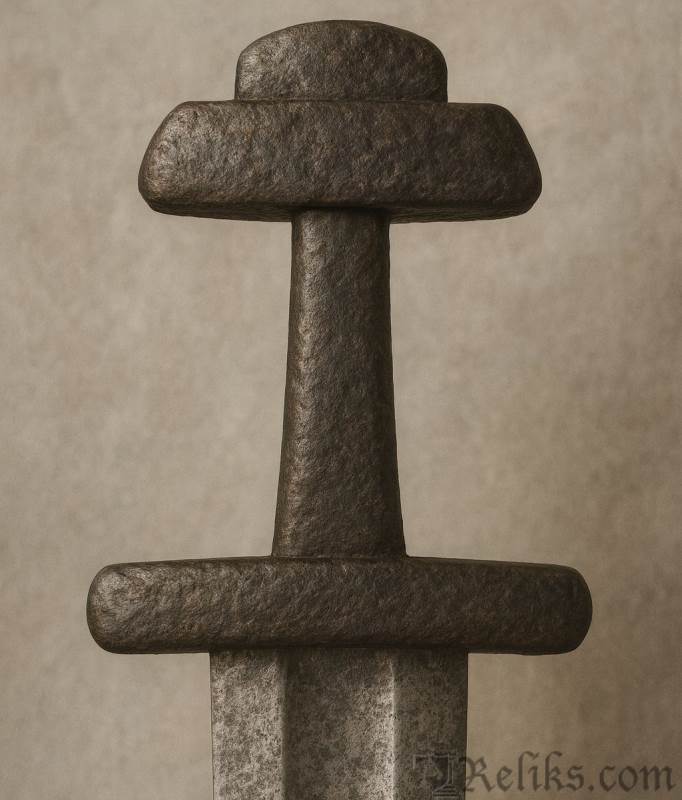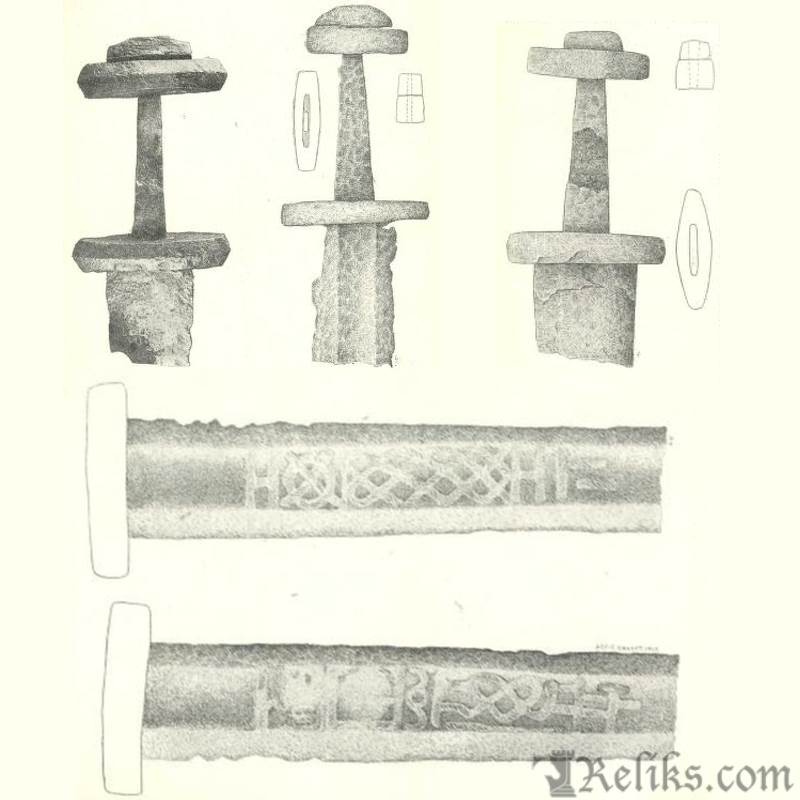Viking Sword Type F – A Plain and Practical Early Form
From Ornament Back to Simplicity
After the richly decorated Types D and E, the Type F sword stands out for its austerity. Instead of elaborate pommels and bronze inlays, this type is marked by a simple iron knob, giving the impression of a sword stripped back to basics. Whether a deliberate design choice or the result of reusing and replacing damaged parts, Type F shows how Viking swords could also embody plain practicality.
Archaeological Description

Viking Sword Type F – A Plain and Practical Early Form
The defining feature of Type F is the short, broad iron pommel. Usually four-sided in section, it sometimes takes a segmental shape or even a polygonal form, as in the Valdres example. The guards are oval in cross-section, typically cut square at the ends like the later M-type, though occasionally pointed-oval like Types D and E.
There is no metal plating or decorative inlay on these hilts. The pommel’s simplicity often makes it look like a replacement — as if a sword of another type had lost its pommel and been re-fitted with this plain iron block. Indeed, Petersen noted a B-type sword later retrofitted with a Type F knob.
Yet, the consistency of surviving examples suggests Type F was also a true type of its own, another stage in the Scandinavian trend toward simplifying earlier, more elaborate forms.
Relationships to Other Types
Type F may be viewed as a simplification of Type G, retaining some of its proportions but abandoning its spiral-beaded ornament. Alternatively, it may connect back to much earlier Migration Period hilts with their low, narrow pommels. In some cases, the outline even hints at a vestige of three-part division, showing the lingering memory of earlier forms.
The type is predominantly single-edged, further linking it to the older Scandinavian tradition of one-edged swords without guards.
Historical & Cultural Context

Petersen Sketches (fig.67,68-69)
Type F belongs to the first half of the 9th century, squarely within the early Viking Age. While other sword types of the time emphasized status through rich decoration, Type F reflects a local, utilitarian tradition. These were working weapons, not ceremonial showpieces.
The prevalence of single-edged blades suggests continuity with older Scandinavian sword-making, even as more continental double-edged forms spread through raiding and contact.
Distribution and Finds
Petersen documented 18 examples in Norway:
- 10 single-edged
- 7 double-edged
- 1 indeterminate
The type is concentrated in Oppland and Hadeland (Kristians amt), with additional examples in Gudbrandsdal, Valdres, and two in Sogn. A handful occur in Trøndelag, but Type F is virtually absent from coastal regions.
Only one specimen is known outside Norway — a sword in the Statens Historiska Museum in Västergötland, Sweden.
Associated finds include:
- Axes of transitional A–H forms, plus one D-type axe.
- Shield bosses (mostly R 564, one R 562).
- At least one C-type sword, and one M-type sword.
- Oval brooches (R 647), helping confirm an early 9th-century date.
For Collectors and Enthusiasts
Though lacking the visual splendor of Type D or E, Type F swords are fascinating for their stark simplicity. They are among the most modest Viking swords, yet also among the most authentically “homegrown.” Their plain knobs and undecorated guards make them rare and intriguing finds for scholars, while their strong link to the Scandinavian single-edged tradition adds cultural depth.
Replicas of Type F are virtually unknown today, but their straightforward design makes them excellent candidates for experimental archaeology and reenactment.
Closing Reflection
Type F reminds us that not every Viking sword was a showpiece of ornament and status. Some were plain, functional weapons, forged for use rather than display. In their simplicity, they carry the weight of the warrior’s daily life more than the chieftain’s ceremony. As Petersen noted, they may even represent re-used or adapted swords — proof that Viking warriors valued practicality as much as prestige.
Core classification based on Jan Petersen, De Norske Vikingesverd (1919). Additional commentary by Reliks.com.